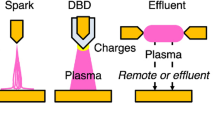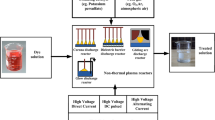Abstract
In this experiment, a gas–liquid two-phase discharge water treatment inverse device was designed independently to treat the actual workshop intermediate dye wastewater from a chemical plant. Firstly, the effects of initial concentration of wastewater, initial pH, circulation flow rate of solution, content of Fe2+, content of H2O2, and addition of tert-butanol on the organic removal rate and decolorization rate of dye wastewater treatment were investigated. The results showed that Fe2+ and tert-butanol would react with the active particles (H2O2, ·OH) and inhibit the degradation of the dye wastewater, resulting in the decrease of both organic matter degradation rate and decolorization rate. The experimentally degraded dye wastewater mainly contained benzoic acid and its derivatives in addition to dye molecules, thus the degradation mechanism of benzoic acid was mainly analyzed. Then, the actual dye wastewater treated by low-temperature plasma was combined with the traditional biological treatment technology. The biochemical properties of the wastewater treated by low-temperature plasma technology were greatly improved, and the B/C was increased from the initial 0.17 to 0.33. The effluent after the combined biological method could meet the effluent discharge standard, and the final CODcr reached 198 mg/L, BOD5 reached 65 mg/L, and pH and chromaticity reached 6.39 and 50, respectively.










Similar content being viewed by others
Data availability
The data and materials for this experiment are available.
References
Aziz KHH, Miessner H, Mahyar A et al (2019) Removal of dichloroacetic acid from aqueous solution using non-thermal plasma generated by dielectric barrier discharge and nano-pulse corona discharge [J]. Sep Purif Technol 216:51–57
Aziz KHH, Miessner H, Mueller S et al (2017) Degradation of pharmaceutical diclofenac and ibuprofen in aqueous solution, a direct comparison of ozonation, photocatalysis, and non-thermal plasma [J]. Chem Eng J 313:1033–1041
Aziz KHH, Mahyar A, Miessner H et al (2018) Application of a planar falling film reactor for decomposition and mineralization of methylene blue in the aqueous media via ozonation, Fenton, photocatalysis and non-thermal plasma: a comparative study [J]. Process Saf Environ Prot 113:319–329
Bruggeman PJ, Kushner MJ, Locke BR et al (2016) Plasma-liquid interactions: a review and roadmap [J]. Plasma Sources Sci Technol 25(5):053002
Chethana M, Sorokhaibam LG, Bhandari VM et al (2016) Green approach to dye wastewater treatment using biocoagulants [J]. ACS Sustain Chem Eng 4(5):2495–2507
Chatterjee S, Lee DS, Lee MW et al (2009) Enhanced adsorption of Congo red from aqueous solutions by chitosan hydrogel beads impregnated with cetyl trimethyl ammonium bromide [J]. Biores Technol 11(100):2803–2809
Chen SH, Zhang J, Zhang CL et al (2010) Equilibrium and kinetic studies of methyl orange and methyl violet adsorption on activated carbon derived from Phragmites australis [J]. Desalination 1–3(252):149–156
Cui YM, Yin RC (2021) The progress of treatment methods of dye wastewater [J]. Sci Technol Rev 18(39):79–87
Chen Q, He BB, Ma YPX et al (2019) Influence of the pH value on the degradation of an azo dye of methyl orange by air discharge plasma. Plasma Process Polym 5(16)
Chavez AM, Rey A, Beltran FJ et al (2016) Solar photo-ozonation: a novel treatment method for the degradation of water pollutants [J]. J Hazard Mater 317:36–43
Deshpande BD, Agrawal PS, Yenkie MKN (2019) Advanced oxidative degradation of benzoic acid and 4-nitro benzoic acid—a comparative study. Adv Basic Sci 2019:2142
Habiba U Siddique TA, Joo TC et al (2017) Synthesis of chitosan/polyvinyl alcohol/zeolite composite for removal of methyl orange, Congo red and chromium(VI) by flocculation/adsorption. Carbohydr Polym 157:1568–1576
Haque MM, Haque HM, Md Khaled M et al (2021) Decolorization, degradation and detoxification of carcinogenic sulfonated azo dye methyl orange by newly developed biofilm consortia. Saudi J Biol Sci 28(1):793–804
Huang QL, Chen CJ, Zhao XL et al (2021) Malachite green degradation by persulfate activation with CuFe2O4@biochar composite: efficiency, stability and mechanism [J]. J Environ Chem Eng 9(4):105800
Hyoung-Sup K, Wright K, Joshua PA et al (2015) Inactivation of bacteria by the application of spark plasma in produced water [J]. Sep Purif Technol 156(2):544–552
Hwang I, Jenog J, You T et al (2018) Water electrode plasma discharge to enhance the bacterial inactivation in water [J]. Biotechnol Biotechnol Equip 32(2):530–534
Iervolino G, Vaiano V, Palma V, et al (2020) Enhanced azo dye removal in aqueous solution by H2O2 assisted non-thermal plasma technology. Environ Technol Innov 19
Jiang B, Zheng JT, Qiu S et al (2014) Review on electrical discharge plasma technology for wastewater remediation [J]. Chem Eng J 236:348–368
Liu Q (2020) Pollution and treatment of dye waste-water. 4th International Symposium on Resource Exploration and Environmental Science, (514):052001, pp 7
Luo YH, Yue XP, Jiang YR et al (2021) Recent progress of advanced oxidation processes in indole degradation [J]. Chem Indust Eng Prog 2(40):1025–1034
Khlyustova A, Sirotkin N (2020) Plasma-assisted oxidation of benzoic acid [J]. Front Chem Sci Eng 4(14):513–521
Malik MA, Ubaid-ur-Rehman, Ghaffar A et al (2002) Synergistic effect of pulsed corona discharges and ozonation on decolourization of methylene blue in water. Plasma Sources Sci Technol 11(3):236–240
Njiki A, Kamgang-Youbi G, Nola M, et al (2020) Biodegradation kinetic studies and optimization for the elimination of azoic and triphenylmethane dyes using an integrated process combining biological treatment and gliding arc plasma. J Chem Technol Biotechnol 1(96):273–282
Qin B, Gu JC, Yin P et al (2021) Research progresses on dye wastewater treatment technology [J]. Environ Prot Chem Indus 1(41):9–18
Saravanan R, Karthikeyan S, Gupta VK et al (2013) Enhanced photocatalytic activity of ZnO/CuO nanocomposite for the degradation of textile dye on visible light illumination [J]. Mater Sci Eng C Mater Biol Appl 33(1):91–98
Sanchez JV, Segundo CT, Palacios EM et al (2019) Elimination of AB210 dye in residual textile water by glow-discharge plasma application [J]. Desalin Water Treat 150:361–366
Tijani JO, Fatoba OO, Madzivire G et al (2014) A review of combined advanced oxidation technologies for the removal of organic pollutants from water [J]. Water Air Soil Pollut 225(9):2102
Tecer LH, Gunduz A, Atav R et al (2020) Investigation of the treatment of textile wastewater with cold atmospheric plasma reactor (Profoks) and reuse of recycled water in reactive dyeing process of cotton [J]. J Natl Fibers 6(19):2382–2389
Tange K, Nomura S, Nakajima J et al (2020) Methylene blue decomposition via various in-liquid plasma methods [J]. J Japan Inst Energy 8(99):99–103
Varjani S, Rakholiya P, Ng HY et al (2020) Microbial degradation of dyes: An overview. Bioresource Technol
Wei Q, Sun JL, Yue XF et al (2007) Photodissociation dynamics of benzoic acid monomer at 266 nm: the OH product channel [J]. Chem Phys Lett 1–3(448):11–15
Wang Z, Lin XZ, Huang YX, et al (2022) The role of hydroxylation on⋅OH generation for enhanced ozonation of benzoic acids: reactivity, ozonation efficiency and radical formation mechanism. J Hazard Mater :431
Yee DC, Chauhan S, Yankclevich E et al (1998) Degradation of perchloroethylene and dichlorophenol by pulsed-electric discharge and bioremediation [J]. Biotechnol Bioeng 59(4):438–444
Zhang CX, Sun YB, Yu ZQ et al (2018) Simultaneous removal of Cr(VI) and acid orange 7 from water solution by dielectric barrier discharge plasma [J]. Chemosphere 191:527–536
Zhang SY, Shen XJ, Li JR et al (2022) Study on degradation of alizarine reds in simulated dye wastewater by gas-liquid two-phase discharge plasma. Chem Eng Process 181
Zhang XH, Zhang CX, Sun XM et al (2019) Mechanism and kinetic study of the reaction of benzoic acid with OH, NO3 and SO4- radicals in the atmosphere [J]. RSC Adv 33(9):18971–18977
Author information
Authors and Affiliations
Contributions
JZ (first author): investigation, writing — original draft.
JL: methodology, validation.
SZ: investigation, formal analysis.
XS* (corresponding author): conceptualization, resources, writing — review and editing, project administration, funding acquisition.
Corresponding author
Ethics declarations
Ethical approval
We guaranteed that the works we submitted were original content, and there was no bad behavior such as plagiarism and fabrication of data. At the same time, we guaranteed that this manuscript has not been submitted to other journals for submission, and there was no phenomenon of submitting to different journals at the same time.
Consent to participate and publish
All authors have agreed to participate in this experiment and consent to the publication of this work.
Conflict of interest
The authors declare no competing interests.
Additional information
Responsible Editor: Guilherme L. Dotto
Publisher's note
Springer Nature remains neutral with regard to jurisdictional claims in published maps and institutional affiliations.
Rights and permissions
Springer Nature or its licensor (e.g. a society or other partner) holds exclusive rights to this article under a publishing agreement with the author(s) or other rightsholder(s); author self-archiving of the accepted manuscript version of this article is solely governed by the terms of such publishing agreement and applicable law.
About this article
Cite this article
Zhang, J., Shen, X., Li, J. et al. Experimental study on the treatment of dye wastewater by plasma coupled biotechnology. Environ Sci Pollut Res 30, 57989–58001 (2023). https://doi.org/10.1007/s11356-023-26590-5
Received:
Accepted:
Published:
Issue Date:
DOI: https://doi.org/10.1007/s11356-023-26590-5




